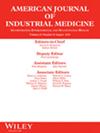California Warehouse Industry Worker Injury Rates in the Occupational Health and Safety Administration's Injury Tracking Application, 2018–2023
Abstract
Background
Occupational health and safety surveillance in the US relies primarily on federal and state administrative data sources which all have limitations created by underreporting and different sampling frames. To begin closing data gaps, in 2019 the federal Occupational Health and Safety Administration began requiring many US business establishments to submit injury and illness data to the Injury Tracking Application (ITA). We present an example use of these data by characterizing injuries in the California warehousing industry.
Methods
Yearly ITA data for 2018–2023 were obtained and cleaned to exclude invalid records, resulting in 3717 records from California General Warehousing and Storage (GWS, NAICS 493110) establishments. Annual rates of total reportable injuries and cases of injuries requiring days of job transfer or restriction (DJTR) were calculated.
Results
Total injury rates peaked in 2021, with 5.87 injuries per 100 workers. While total injury rates subsequently declined, 2023 DJTR rates remained elevated over 2018 rates (3.21 vs. 1.84 per 100 workers). The primary analytical limitations were potential bias due to underreporting, and difficulty in identifying warehouse establishments.
Conclusion
The ITA data are a valuable addition to existing administrative data sources, with several limitations similar to those in other administrative datasets. The findings of consistently elevated total and DJTR injury rates in California's warehousing industry are consistent with previous research and indicate that outreach and enforcement efforts should be expanded to protect the health and safety of warehouse workers.

 求助内容:
求助内容: 应助结果提醒方式:
应助结果提醒方式:


